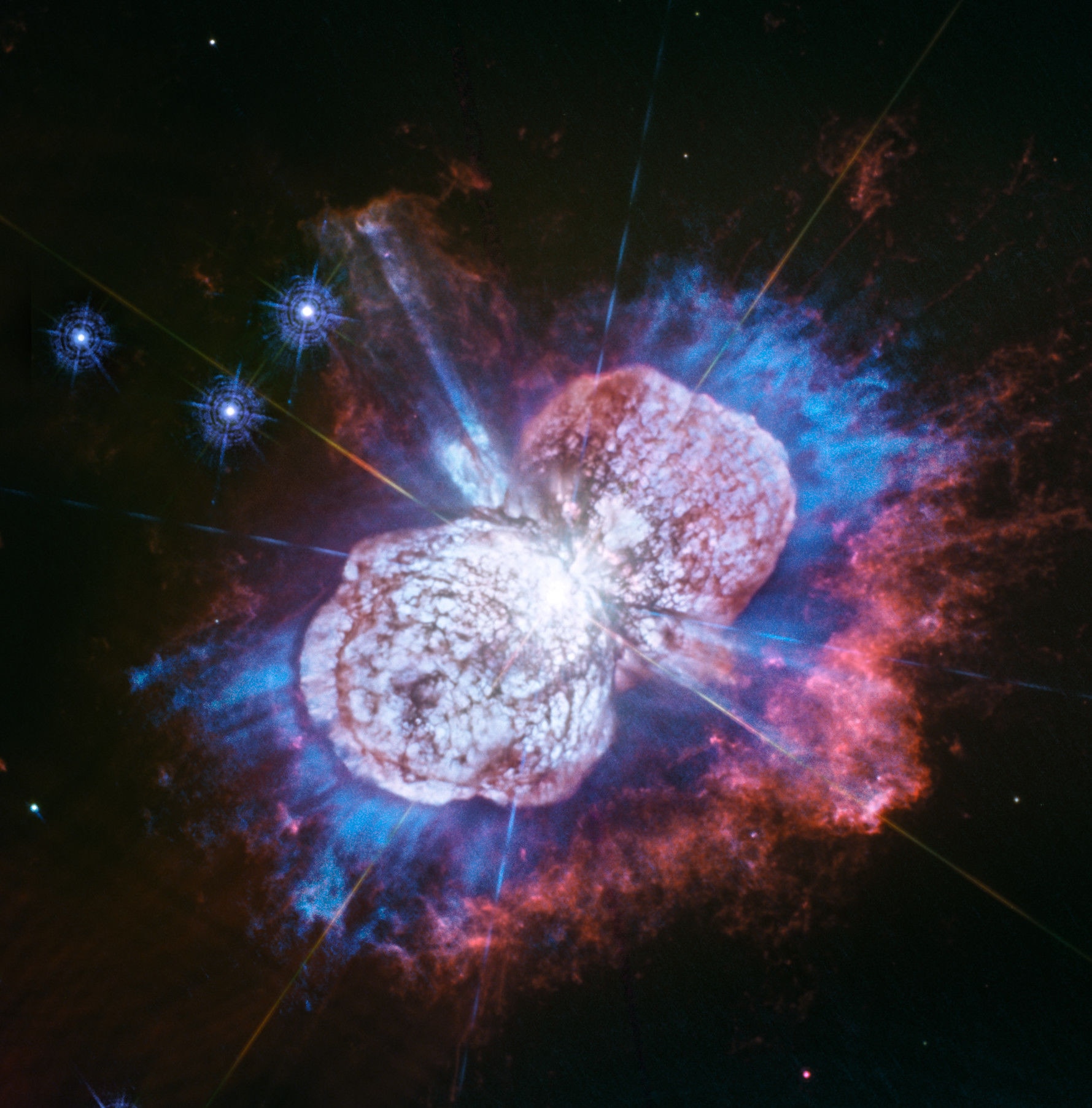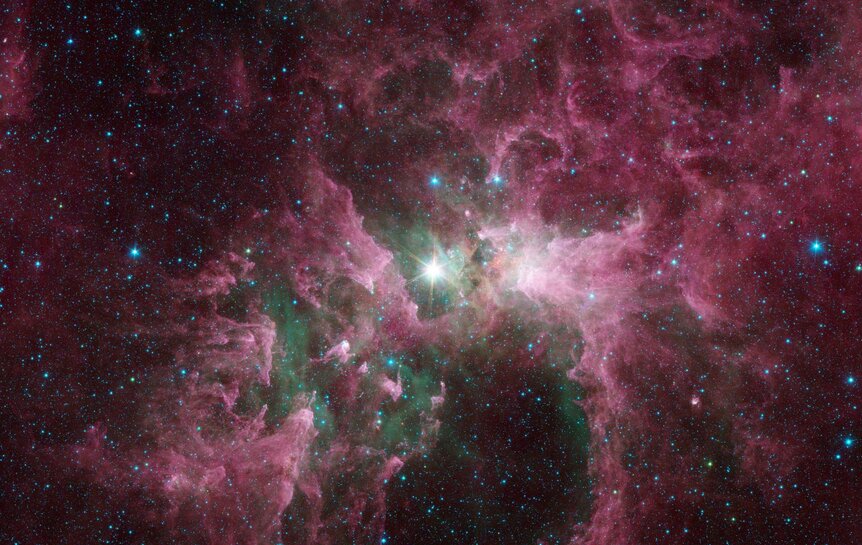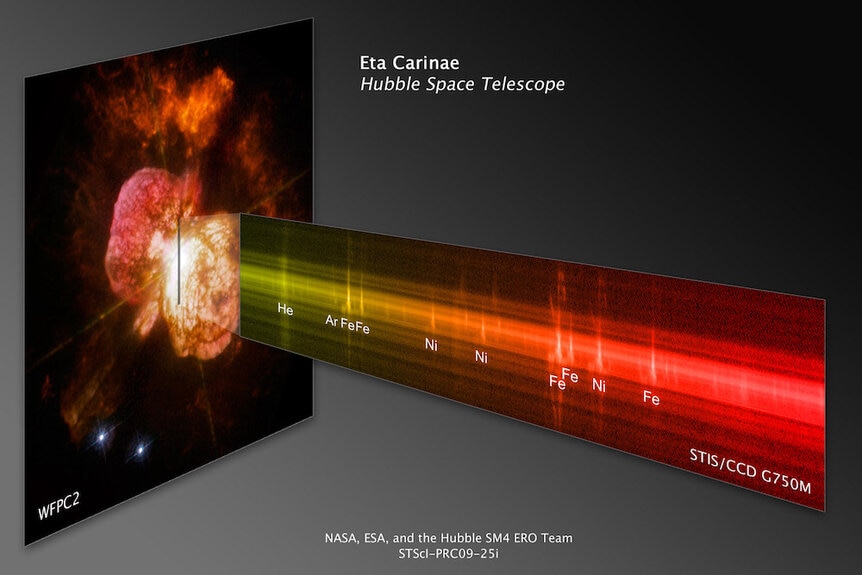Create a free profile to get unlimited access to exclusive videos, sweepstakes, and more!
Peeling back the layers on Eta Carinae, the galaxy's most terrifying star
Eta Car is a monster, surrounded by the debris of violent eruptions.

Let us take a moment to admire the star Eta Carinae. Happily, we do so from a distance of 7,500 light years. I don't think we'd want to get too much closer.
That's because it's one of the most terrifying stars in the sky. Or two of them, I should say — it's a binary star, two stars orbiting each other, and both are beasts. One is something like 50 times the mass of the Sun, a huge powerhouse that, any other place in the galaxy, would outshine everything around it.
But it's right next to a star that has at least a hundred times the Sun's mass — a hundred — and the amount of energy a star gives off is very sensitive to its mass. This bigger star of the two, called the primary, is at least a million times more luminous than the Sun.
One. MILLION. Times. At least.
And even that is not the reason I'm happy it's comfortably far away.
In the 1830s the primary erupted in an event so colossal it was just this side of a supernova. The blast of matter and energy was titanic, mind-crushing: over time it launched something like 20 times the mass of Sun worth of gas and dust into space at high velocity. This material has been expanding away ever since, forming a pair of lobes forming an hourglass shape. There is also material farther out from the star, likely blown out in earlier, smaller eruptions.
Today we're left with an astonishingly complex and beautiful structure around Eta Carinae, one that's difficult to untangle and understand.
But not impossible! Using observations that span the spectrum from infrared to X-rays using Hubble, Spitzer, and Chandra, a team of astronomers and visual artists has created a stunning 3D animation of Eta Carinae, showing models of what it looks like in these different wavelengths, peeling away the layers of the structure to make what's going on there more clear. Watch:
Whoa.
The double-lobed structure is called the Humonculus Nebula. This sort of hourglass figure is common in stars that blow out gas. Usually it means there's a dense disk of material around the star's equator, and when the gas gets blown out it has a harder time moving in the equatorial direction, so it expands up and down from the disk, two bubbles inflating as the star erupts.
There is evidence of such a disk in the Eta Carinae observations, which may have formed via interactions of the primary behemoth and the still-very-huge secondary star as they orbit each other. It's also possible the primary star is a rapid rotator, spinning on its axis so quickly that material is flung away along its equator, forming that thick disk.
The hydrogen and nitrogen blasted out in the eruption glow red in visible light, forming the overall shape of the lobes. The two stars are also bright in ultraviolet light, shown in blue in the video. Some of this is also from ionized magnesium, also blasted out in the eruption, which glows in UV.
This fierce light shines through gaps in the disk material closer in, creating beams of light called crepuscular rays, the same phenomena you see when the setting Sun shines light through clouds and creates a fan of rays spreading out.
Farther out is the material ejected in earlier episodes, glowing red again from hydrogen. Outside of that is a cloud of material so energetic it glows in X-rays, very high-energy light. This may be due to fast-moving material slamming into the gas at greater distance from the stars — Eta Carinae sits near the center of the vast and magnificent Carina Nebula — emitting X-rays due to the powerful shock waves created there.
X-rays are also emitted very close in to the stars as well. The secondary star is on an orbit that's highly elliptical, taking it from a distance of about 4.5 billion kilometers out down to only 250 million kilometers. Both stars emit a fast, dense wind of subatomic particles, and where these winds collide they emit X-rays. This emission is seen to wax and wane on a 5.5 year cycle, presumably the time it takes the stars to orbit each other.
Not shown in the video is the infrared light, emitted by dust around the system. A huge fraction of the light from the stars is absorbed by this dust, which warms it up enough to glow in the infrared. There's so much dust, and so much energy, that in mid-infrared — wavelengths of a few microns, well outside what our eyes can detect — it's the brightest source in the sky!
Years ago, when I worked on the Space Telescope Imaging Spectrograph instrument on Hubble, we got many spectra of Eta Carinae, and every time I looked at them I got a headache. They were a mess, a jumble of emission from a dozen different tortured elements like hydrogen, nitrogen, and iron, flung around at such high velocity the spectra got smeared out or distorted into very peculiar shapes. Interpreting them was... difficult.
But worth doing! Not many stars get as massive as Eta Carinae, and the physics of how they behave is poorly understood. We do know that stars that massive tend to be unstable. The upper layers are so energetic the star can barely hold on to them, and this is exacerbated by the star's core being so massive that its energy production can suddenly jump in rate by huge amounts, pumping all that energy into the star's envelope, which can cause ridiculously powerful eruptions.
And one thing we do know for sure is that Eta Carinae won't be around long. In the cosmically near future, probably less than a million years from now and perhaps much less, the core of the mighty star will run out of fuel. It will rapidly collapse, generating truly prodigious amounts of energy, and the outer layers of the star will explode. In other words it will go supernova, probably blasting out enough energy to outshine the entire Milky Way galaxy's worth of stars. It'll be more brilliant than Venus in our night sky, getting bright enough to cast distinct shadows.
And that, that, is the real reason I'm glad we're 7,500 light years away. Close enough to study it and try understand its complexities, but far enough away that we don't get vaporized by it. I think that's a fine compromise.




























